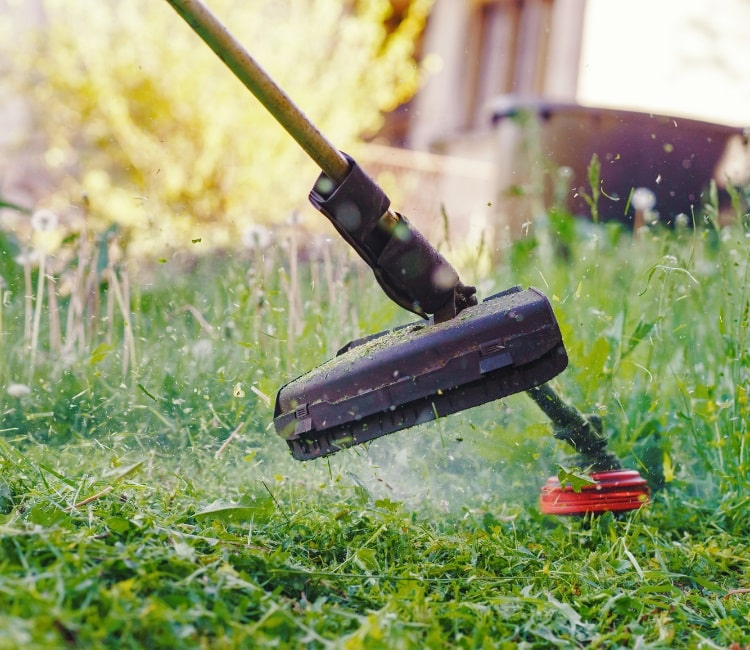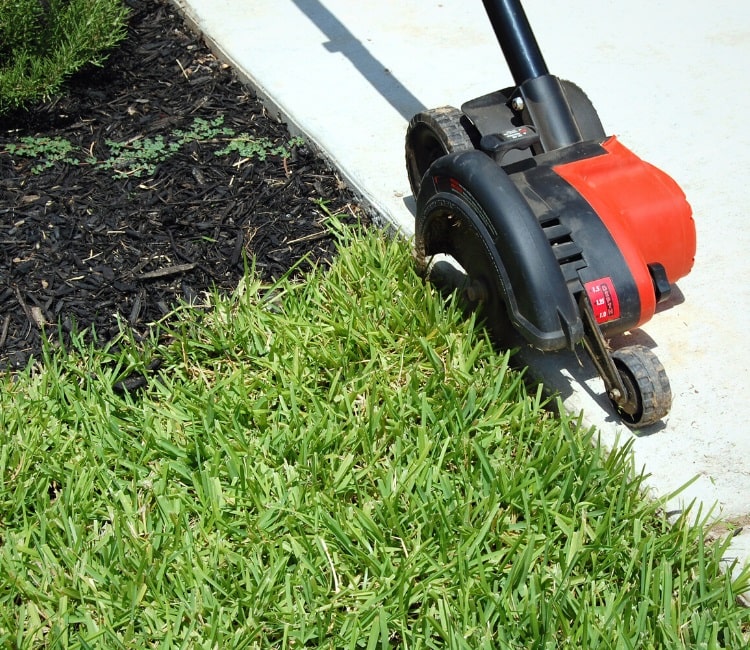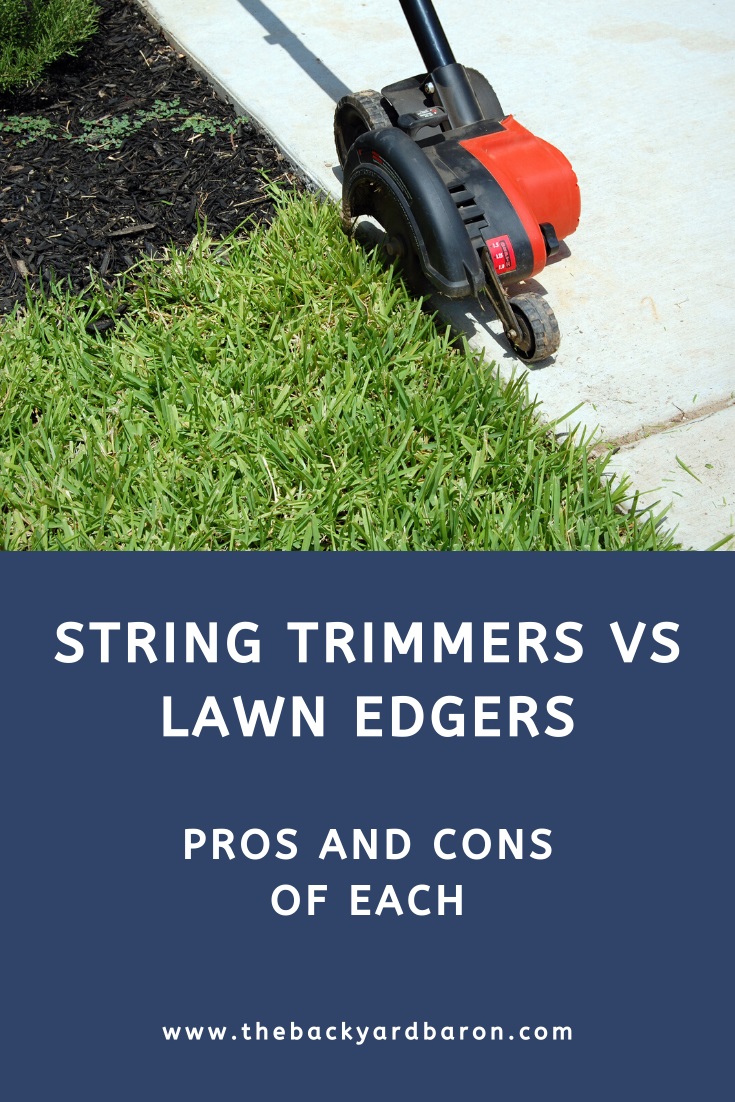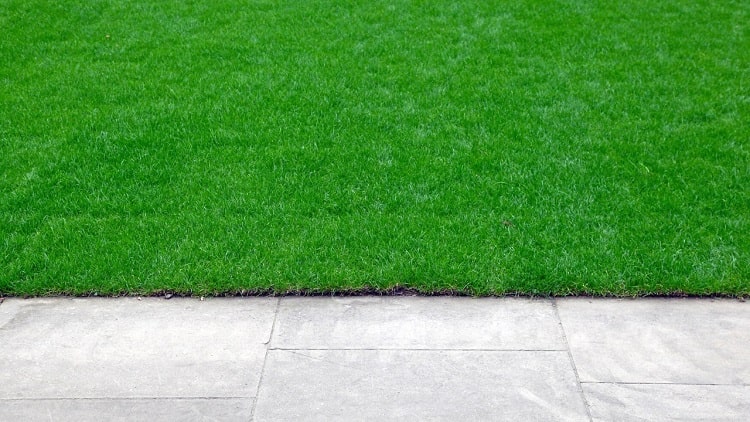I may earn a small commission from purchases made through product links on this website at no extra cost to you. As an Amazon Associate I earn from qualifying purchases.
Last updated: January 21, 2024
A guide outlining the key differences between lawn edgers and string trimmers, when to use each, and the pros and cons of both tools.
The search for the right tools to keep your yard in the best shape often brings people to the debate over lawn edgers vs string trimmers. These two tools are very similar and can do some of the same jobs, which further complicates the differences between them.
If you’re interested in buying a string trimmer or edger, keep reading. I will go through the differences between the two tools and explain the different types of lawn edgers and string trimmers available.
String Trimmer or Edger?
Both string trimmers and lawn edgers are used to sculpt and finish your yard for a clean final product.
But they each have many other uses beyond that, as well as some overlapping functionality. To fully understand how these two yard tools differ, let’s first take a closer look at each.
What Is a String Trimmer?
A string trimmer, also known as a weed whacker or weed eater, is a long-handled tool with a string spool on the end.
This spool holds one or two lengths of hard plastic string and spins at a high velocity, effectively turning those strings into blades.
When to Use a String Trimmer?
String trimmers are used primarily to trim down lawns and weeds. They are especially useful in tight areas that your lawnmower cannot reach. However, they do not have wheels or legs on the bottom to dictate cutting height, so they are less precise than a mower.
Areas of thick overgrowth can also be cleaned up using a string trimmer. Very powerful models can even be used to tackle brambles and woody brushes.

While mainly used with the strings moving parallel to the ground, string trimmers can also be used with the strings spinning perpendicular to the ground.
In this setup, they can be used in the same way as edgers to clean up overgrowth at lawn borders. The strings, however, are not powerful enough to cut through soil.
Many string trimmer models are set up as “2-in-1” edger-trimmer tools. On these products, the head can be rotated to face down for trimmer use or sideways for edging use. Some even have a small wheel on the head to help create straighter, uniform lines while edging.
Types of String Trimmers
String trimmers come in a variety of types:
- Battery-powered string trimmers:
Battery string trimmers are great for large yards and areas far from power sources. But, of course, they are limited by their battery life. Newer models are much more powerful than old battery-style trimmers but aren’t likely to be as good at battling thick, woody debris as a gas-powered unit. These powerful models are also fairly expensive compared to other options. - Corded electric string trimmers:
Corded string trimmers have similar power ratings to high-end battery models but are limited in where they can be used since they must be plugged in. On the plus side, they will run as long as you need them to and tend to be quieter and easier to maintain than gas-powered units. You do have to be extra careful with these models because it is easy to accidentally cut through your extension cord with the string head. - Gas-powered string trimmers:
Gas string trimmers are the best option if you’ll be tackling a lot of thick debris like brush and large weeds. These are consistently the most powerful options but do come with more maintenance and tend to be loud and stinky.
For all options here, the quality and power output will vary by brand, and it requires some research to find the right model for your needs.
What Is a Lawn Edger?
A lawn edger, or edge trimmer, is a long-handled or push tool with a flat blade that is used to create clean lines at lawn borders. A manual lawn edger looks similar to a spade but with a small, half-circle flat blade on the end.
Motorized edgers come in many varieties. Some look similar to a string trimmer but with a flat two or three-pronged spinning blade at the end.
Push versions look more like a lawnmower, but with a flat spinning blade that runs perpendicular to the ground mounted on the side rather than a parallel blade mounted beneath.
When to Use a Lawn Edger?
The blade of a lawn edger cuts overhanging grass, weeds, and debris in a clean, continuous line. They are typically used where lawn borders pathways, sidewalks, driveways, or garden beds.

In addition, the blade of some models is strong enough to penetrate the dirt to further clean up edges and remove soil buildup.
These more powerful models can also be used to cut turf into strips so it can easily be removed. If you don’t have a sod cutter, this is the next best thing to use to create paths or garden beds on your lawn.
Types of Lawn Edgers
Lawn edgers, or edge trimmers, come in a variety of types:
- Manual edgers:
Manual trimmers, as I mentioned above, are basically specialized spades. By applying pressure with your foot, you can force the blade into the ground to remove areas of turf or cut grass along a border. These are cheap and easy to store but take a lot more effort and time to use. - Battery-powered edgers:
Battery-powered lawn edgers are great for working areas farther from outlet access, but they tend to be more expensive and must be charged frequently. Newer models are much more powerful than what used to be available but are still unlikely to be as effective as gas-powered wheeled units. - Corded electric edgers:
Corded varieties will run as long as you need them to but require extension cords, which can limit their use radius. These tend to have decent power and are less expensive than battery-powered options with the same output. However, they still aren’t as powerful as gas models. - Gas-powered edgers:
Gas-powered edgers run longer than battery-powered ones and can be used wherever you need them. But they require more maintenance, can put off noxious odors, and tend to be loud.
Large wheeled edgers that are capable of penetrating deep into the soil tend to be gas-powered. These powerful units are great for getting very clean edges and battling soil buildup, but they’re also very bulky and take a lot of room to store.
Now, let’s discuss string trimmer and edger combo tools.
True 2-in-1 Tools
There are a few true edger-trimmer options out there that are worth mentioning.
Not only do the heads on these models change position based on whether you’re edging or trimming, but they also come with replaceable blades.
With these options, you get a string spool for trimming and a flat blade for edging. The string trimmer option is generally comparable to other straight-string trimmer models.
The edger option isn’t as precise or powerful as a wheeled model but is comparable to a mid-range handheld edger.
- [TRIMMER & EDGER 2-in-1] Easily converts from a string trimmer to an edger lawn...
- [INSTANT LINE FEED] This grass trimmer has innovative push button Command Feed...
- [HEAD TILTS 90°] So you can use string trimmer and edger on sloped terrain, and...
Key Differences
String trimmers have the benefit of being able to edge lawns as well as trim grass and weeds. But they are not nearly as precise as true lawn edgers and are not set up to cut through soil.
These aren’t the only differences between these two tools. The table below outlines what makes string trimmers and lawn edgers different and can help you decide which tool is best for your needs, or if it’s worth buying both.
| Consideration | Lawn Edger | String Trimmer |
|---|---|---|
| Main function: | To create clean borders along lawn edged. | To trim tall grass and weeds. |
| Additional functions: | Cut into soil to remove dirt buildup along borders, cut turf into strips for removal. | Clear brambles, brush, cut lawn where mower can’t reach, and edge lawn overgrowth. |
| Types available: | Manual, battery, corded, gas. | Battery, corded, gas. |
| Pros: | Provide clean, precise edges along paths and sidewalks, can penetrate dirt to reduce future overgrowth or help remove sod, affordable manual options available. | Variable uses, many come with 2-in-1 functionality, easy to maneuver. |
| Cons: | Restricted uses, can be bulky. | Cannot penetrate soil, not all models are powerful enough to cut through thick debris, harder to get precise, finished look. |
| Price: | $30 to $600+ | $40 to $300+ |
Conclusion
If your main goal for buying a new yard tool is to clean up the edges of your lawn, then a lawn edger is the tool you want. These tools are made specifically for cutting back overgrowth and soil buildup at the borders between sidewalks, driveways, paths, and garden beds. Their uses are limited to this work, but they make the job easy and leave you with a clean finished product.
On the other hand, if your main goal is to find something that can clean up those grassy areas your mower can’t reach or take down weedy growth, a string trimmer is your best bet. These versatile tools are great for cleaning up those shabby parts of your yard. They can even edge lawns to some degree but won’t give you as precise of lines or as clean a final product as an edger.
For those who want that ultra-groomed look across the entire yard, then buying both an edger and a string trimmer or a true 2-in-1 tool is the best way to go.
If you’re looking for more ways to tackle excess grass growing in and around places such as walkways and flower beds, read my guide to the best handheld grass shears with reviews of some of the best shears available.


